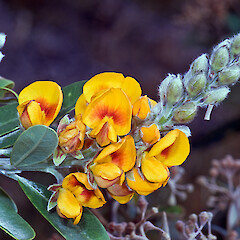Callistachys lanceolata
Common name
oxylobium
Family
Fabaceae
Flora category
Vascular – Exotic
Structural class
Trees & Shrubs - Dicotyledons
Conservation status
Not applicable
Habitat
Terrestrial. Waste places, scrubland, often in sandy coastal sites (Webb et al 1988).
Detailed description
Tall shrub; twigs densely sericeous, angular. Leaves irregularly verticillate or opposite, finely sericeous above and below when young but almost glabrous above when older, entire, obovate to elliptic, acute to obtuse or slightly retuse, mucronate, 35~55mm long; midvein prominent; petiole 2~5mm long; stipules sericeous, linear, 2~4mm long. Infl. terminal, racemose, dense, with numerous flowers; pedicels 3~5mm long; bracts and bracteoles sericeous, deciduous. Calyx densely sericeous, teeth >=tube. Corolla orange-yellow, usu. with reddish markings, 10~15mm long. Pod densely sericeous, ribbed and very hard, dehiscent through the apex only, crescent-shaped, 6~8-seeded. 13~17mm long; seeds dull reddish black, scarcely strophiolate. (- Webb et. al., 1988)
Similar taxa
Silvery tall shrub, often not branching much, twigs angular with dense coverage of silky hair. Oval leaves tend to be upright. Conspicuous orange-yellow flower spikes with reddish markings, November. Pod half-moon shaped with 6-8 dull reddish black seeds (DoC, 1998).
Flowering
November
Flower colours
Orange, Yellow
Life cycle
Perennial.
Year naturalised
1931
Origin
West Australia
Reason for introduction
Ornamental
Etymology
lanceolata: Lance-shaped





